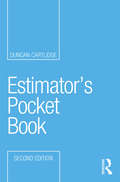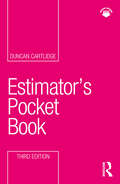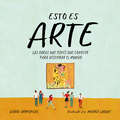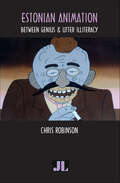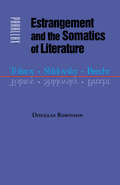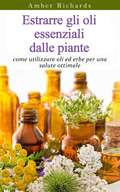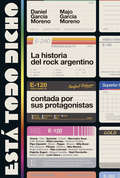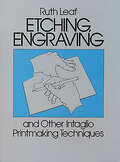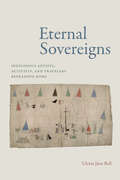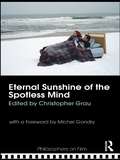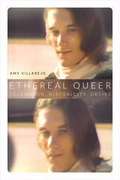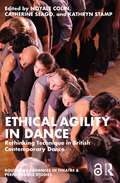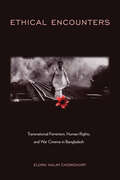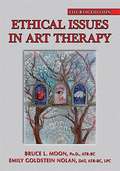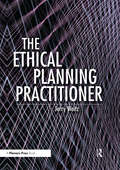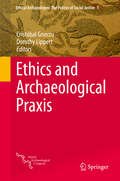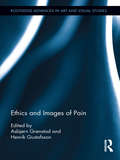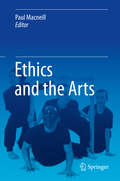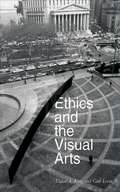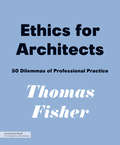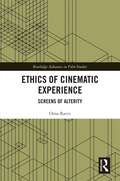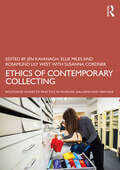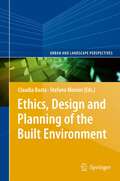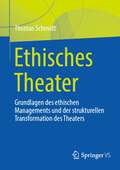- Table View
- List View
Estimator's Pocket Book 2e (Routledge Pocket Books)
by Duncan CartlidgeThe Estimator’s Pocket Book, Second Edition is a concise and practical reference covering the main pricing approaches, as well as useful information such as how to process sub-contractor quotations, tender settlement and adjudication. It is fully up to date with NRM2 throughout, features a look ahead to NRM3 and describes the implications of BIM for estimators. It includes instructions on how to handle: the NRM order of cost estimate; unit-rate pricing for different trades; pro-rata pricing and dayworks; builders’ quantities; approximate quantities. Worked examples show how each of these techniques should be carried out in clear, easy-to-follow steps. This is the indispensable estimating reference for all quantity surveyors, cost managers, project managers and anybody else with estimating responsibilities. Particular attention is given to NRM2, but the overall focus is on the core estimating skills needed in practice. Updates to this edition include a greater reference to BIM, an update on the current state of the construction industry as well as up-to-date wage rates, legislative changes and guidance notes.
Estimator’s Pocket Book (Routledge Pocket Books)
by Duncan CartlidgeThe Estimator’s Pocket Book, Third Edition is a concise and practical reference covering the main approaches to pricing, as well as useful information such as how to process sub-contractor quotations, tender settlement and adjudication. It is fully up to date with the New Rules of Measurement (NRM2) (2nd Edition) throughout and based on up-to-date wage rates, legislative changes and guidance notes.The book includes instructions on how to carry out:· an NRM order of cost estimate,· unit-rate pricing for a range different trades,· pro rata pricing for variations, and· the preparation and pricing of builders’ quantities and approximate quantities.This book is an essential source of reference for quantity surveyors, cost managers, project managers and anybody else with estimating responsibilities.
Esto es arte
by David ArmengolDescubre 15 obras de arte que cambiaron el mundo, ¡y entiende por fin por qué son famosas! ¿Por qué Los girasoles de Van Gogh se han convertido en cojines, sábanas, imanes de nevera? ¿Por qué La Gioconda vale millones y mi retrato no? El arte a veces es incomprensible. Precisamente por eso es arte. Pero con lo de incomprensible podemos echarte una mano. En este libro vas a encontrar un recorrido por la historia del arte, explicada en 15 grandes obras maestras, y descubrirás también las razones por las que son tan famosas y por qué han sobrevivido al paso del tiempo. ¿Estás preparado para aprender a mirar el arte? Y mejor todavía: ¿estás preparado para aprender a mirar como un artista?
Estonian Animation: Between Genius & Utter Illiteracy
by Chris RobinsonEver wonder why Estonian animation features so many carrots or why cows often perform pyramids? Well, neither question is answered in Chris Robinson's new book, Estonian Animation. Robinson's frank, humorous, and thoroughly researched book traces the history of Estonia's acclaimed animation scene from early experiments in the 1930s to the creation of puppet (Nukufilm) and cel (Joonisfilm) animation studios during the Soviet era, as well as Estonia's surprising international success during the post-Soviet era. In addition, Robinson writes about the discovery of films by four 1960s animation pioneers who, until the release of this book, had been unknown to most Estonian and international animation historians.
Estrangement and the Somatics of Literature: Tolstoy, Shklovsky, Brecht (Parallax: Re-visions of Culture and Society)
by Douglas RobinsonDrawing together the estrangement theories of Viktor Shklovsky and Bertolt Brecht with Leo Tolstoy's theory of infection, Douglas Robinson studies the ways in which shared evaluative affect regulates both literary familiarity—convention and tradition—and modern strategies of alienation, depersonalization, and malaise.This book begins with two assumptions, both taken from Tolstoy's late aesthetic treatise What Is Art? (1898): that there is a malaise in culture, and that literature's power to "infect" readers with the moral values of the author is a possible cure for this malaise. Exploring these ideas of estrangement within the contexts of earlier, contemporary, and later critical theory, Robinson argues that Shklovsky and Brecht follow Tolstoy in their efforts to fight depersonalization by imbuing readers with the transformative guidance of collectivized feeling. Robinson's somatic approach to literature offers a powerful alternative to depersonalizing structuralist and poststructuralist theorization without simply retreating into conservative rejection and reaction.Both a comparative study of Russian and German literary-theoretical history and an insightful examination of the somatics of literature, this groundbreaking work provides a deeper understanding of how literature affects the reader and offers a new perspective on present-day problems in poststructuralist approaches to the human condition.
Estrarre gli oli essenziali dalle piante: come utilizzare oli ed erbe per una salute ottimale
by Amber Richards Piera BiffardiScoprite i benefici per la salute derivanti dall'uso degli oli essenziali, per voi e per la vostra famiglia. Estraendoli dalle piante e dalle erbe dei dintorni, avrete la possibilità di risparmiare denaro e sarete certi della loro freschezza. Scoprite ricette e miscele uniche, che vi consentiranno di trattare in maniera naturale molte patologie. Gli oli essenziali, oli volatili o oli eterei sono liquidi concentrati che contengono una combinazione di sostanze chimiche delle piante, utili per molti scopi che avrete la possibilità di approfondire. Possono essere utilizzati per la produzione di profumi, saponi, cosmetici e molti altri prodotti. Nel corso della storia gli oli essenziali hanno svolto, e continuano a svolgere, un ruolo importantissimo nella cura di disturbi come: ✔ Raffreddori e influenza ✔ Artrite ✔ Insonnia ✔ Sistema immunitario debole ✔ Bronchite ✔ Acne ✔ Graffi e tagli poco gravi ✔ Affaticamento ✔ Problemi digestivi ✔ Pressione alta ✔ E TANTO ALTRO! In questo e-book vengono svelati metodi semplici per produrre i propri oli essenziali direttamente da piante ed erbe, nonché molte ricette per affrontare questi problemi di salute e per molti altri usi. Questa guida vi fornisce una panoramica generale della storia degli oli essenziali e termina illustrando metodi molto semplici per distillare, miscelare e utilizzare gli oli essenziali in molte situazioni diverse. Sperimentate in prima persona i miglioramenti di salute e l'aumento di energia, derivanti dall'utilizzo degli oli essenziali.
Está todo dicho: La historia del rock argentino contada por sus protagonistas
by Daniel García Moreno Majo García MorenoLa historia oral y coral definitiva del rock argentino: a través del testimonio de sus grandes protagonistas -de Charly, Fito y Spinetta a Cerati, Prodan, Vicentico, Ciro, Pity, Litto Nebbia, Lebón, Javier Martínez y 70 figuras más-, registrado a lo largo de numerosos programas producidos para la televisión de los años 80 por Daniel y Josi García Moreno, toma forma un relato extraordinario. Pocas personas han hecho tanto por documentar el origen y el devenir del rock rioplatense -una historia que abarca ya más de cinco décadas- como los hermanos Dany y Josi García Moreno. A través de numerosos programas televisivos (Rocanrol, La Cueva, Quizás porqué), y documentales como 30 años de rock nacional, fueron creando un registro audiovisual extraordinario. En las voces de decenas de artistas entrevistados para esas producciones y transcriptas en este libro, hoy toma forma una mirada múltiple y diversa sobre el movimiento y las circunstancias que debió atravesar en un mundo de inestabilidad institucional, prejuicios y grosera censura. Una versión posible de qué es el rock argentino. El relato coral de una historia única. «A lo largo de décadas, Dany y Josi García Moreno y Eduardo Berti grabaron a todos, desde los pioneros hasta las nuevas generaciones. Realizaron reportajes memorables de enorme valor histórico y confesiones increíbles. Si alguien se tomara el trabajo de desgrabar, ordenar y dar forma a ese material, sería un libro formidable. Por suerte, Dany y su sobrina Majo (productora y periodista) se animaron a encararlo. Y este es el resultado».Marcelo Fernández Bitar «Hay algo fascinante en este collage: cada una de las voces habla desde un lugar diferente y desde un tiempo distinto. No solamente este libro no se hizo desde hoy, sino que se hizo desde múltiples pasados, lo que depara una suerte de caleidoscopio móvil (...), una banda sonora documental sobre la banda sonora musical de más de una generación. Una apasionante carambola a dos bandas».Eduardo Berti «Cuando apareció el rock en castellano fue un impacto extraordinario: ¿Cómo? ¿Se puede cantar rock en español?».Javier Martínez «Para nosotros naufragar era quedarnos de bohemia hasta las 8 o 9 de la mañana. Aparecía la gente que se iba a trabajar, que recién se levantaba, y nosotros que no nos habíamos acostado siquiera, éramos los sobrevivientes del naufragio».Litto Nebbia «Esa época, los años 70, era peligrosa y linda. Yo escuchaba la sirena y ya me ponía contra la pared porque pensaba que siempre era para mí. (Pero) nosotros éramos imparables, teníamos una misión».David Lebón «Yo creo en las cosas que transforman y creo que, de alguna manera, con mi música he transformado algunas pautas».Spinetta «Creo que los fans de Los Redondos no tienen la más puta idea de qué hablan las letras. Y así y todo, las cantan y se emocionan. Es el poder del arte».Lito Vitale «(En la música de Charly García) escuchás que la alegría no es solo brasilera por primera vez en la historia argentina. Porque parece que el único pulso vital que ha tenido Argentina ha sido el de la guerra, la sangre, las peleas estéticas y la tragedia. Y en Charly eso aparece como una cosa novedosa... la alegría. Es la idea más importante que veo en Charly y posiblemente en el rock».Fito Páez
Etching, Engraving and Other Intaglio Printmaking Techniques (Dover Art Instruction)
by Ruth LeafIntaglio printmaking involves engraving or incising a figure in stone or other hard material to obtain an impression from the subsurface design. In this thorough handbook, a noted printmaker and teacher offers complete up-to-date coverage of etching, engraving, drypoint, and other well-known intaglio techniques, as well as such less-familiar methods as tuilegraphs, collagraphs, and transfers.The first part of the book is devoted to a thorough introduction to materials and tools, printing equipment, papers, presses--even how to set up your workshop for maximum safety and efficiency. In Part Two, the author proceeds to a detailed discussion of etching techniques, including formulas for grounds and inks, aquatint, white ground, hard ground, soft ground, sugar lift, and acids.Once familiar with basic etching techniques, the student is then given precise illustrated instructions in printing techniques, including basic printing, double intaglio printing (the author's own method); color printing and embossing, the viscosity method, and viscosity and aquatint. For each procedure, clear, step-by-step directions cover the process itself, materials and equipment required, and cleanup. An especially helpful "what went wrong" section at the end of each chapter diagnoses problems and offers solutions.In Part 4 Ms. Leaf details other mediums and methods: drypoint, notable for its characteristic velvety dark lines; engraving, one of the earliest forms of expression known to man, dating back to prehistoric times; collagraphs, plates made in the same way as collages and then printed; and the Blake Transfer Method, adapted from a technique developed by the English artist and poet William Blake (1757-1827).A final Appendix treats such ancillary topics as framing and matting prints, storage, agents, and where to sell and show your work. Enhanced with over 220 illustrations, including works by Rembrandt, Callot, Dürer, Goya, and Brueghel, and a wealth of illustrative figures and photographs, this precise and detailed manual belongs at the side of any serious printmaker, novice, or ink-stained veteran. "Excellent, comprehensive . . . superbly organized." -- AB Bookman's Weekly.
Eternal Sovereigns: Indigenous Artists, Activists, and Travelers Reframing Rome
by Gloria Jane BellIn 1925, Pius XI staged the Vatican Missionary Exposition in Rome’s Vatican City. Offering a narrative of the Catholic Church’s beneficence to a global congregation, the exposition displayed thousands of cultural belongings stolen from Indigenous communities, which were seen by one million pilgrims. Gloria Jane Bell’s Eternal Sovereigns offers critical revision to that story. Bell reveals the tenacity, mobility, and reception of Indigenous artists, travelers, and activists in 1920s Rome. Animating these conjunctures, the book foregrounds competing claims to sovereignty from Indigenous and papal perspectives. Bell deftly juxtaposes the “Indian Museum” of nineteenth-century sculptor Ferdinand Pettrich, acquired by the Vatican, with the oeuvre of Indigenous artist Edmonia Lewis. Focusing on Turtle Island, Bell analyzes Indigenous cultural belongings made by artists from nations including Cree, Lakota, Anishinaabe, Nipissing, Kanien’kehá:ka, Wolastoqiyik, and Kwakwaka’wakw. Drawing on years of archival research and field interviews, Bell provides insight into the Catholic Church’s colonial collecting and its ongoing ethnological display practices. Written in a voice that questions the academy’s staid conventions, the book reclaims Indigenous belongings and other stolen treasures that remain imprisoned in the stronghold of the Vatican Museums.
Eternal Sunshine of the Spotless Mind (Philosophers on Film)
by Christopher GrauEternal Sunshine of the Spotless Mind is one of the most widely discussed and thought-provoking films of recent years. This is the first book to explore and address the philosophical aspects of Eternal Sunshine of the Spotless Mind. Beginning with a helpful introduction that places each essay in context, specially commissioned chapters examine the following topics: philosophical issues surrounding love, friendship, affirmation and repetition the role of memory (and the emotions) in personal identity and decision-making the morality of imagination and ethical importance of memory philosophical questions about self-knowledge and knowing the minds of others the aesthetics of the film considered in relation to Gondry’s other works and issues in the philosophy of perception Including a foreword by Michel Gondry and a list of further reading, this volume is essential reading for students interested in philosophy and film studies.
Ethereal Queer: Television, Historicity, Desire
by Amy VillarejoIn Ethereal Queer, Amy Villarejo offers a historically engaged, theoretically sophisticated, and often personal account of how TV representations of queer life have changed as the medium has evolved since the 1950s. Challenging the widespread view that LGBT characters did not make a sustained appearance on television until the 1980s, she draws on innovative readings of TV shows and network archives to reveal queer television's lengthy, rich, and varied history. Villarejo goes beyond concerns about representational accuracy. She tracks how changing depictions of queer life, in programs from Our Miss Brooks to The L Word, relate to transformations in business models and technologies, including modes of delivery and reception such as cable, digital video recording, and online streaming. In so doing, she provides a bold new way to understand the history of television.
Ethical Agility in Dance: Rethinking Technique in British Contemporary Dance (Routledge Advances in Theatre & Performance Studies)
by Noyale Colin Catherine Seago Kathryn StampThis edited collection examines the potential of dance training for developing socially engaged individuals capable of forging ethical human relations for an ever-changing world and in turn frames dance as a fundamental part of human experience. This volume draws together a range of critical voices to reflect the inclusive potential of dance. The contributions offer perspectives on contemporary dance training in Britain from dance educators, scholars, practitioners and artists. Through examining the politics, values and ethics of learning dance today, this book argues for the need of a re-assessment of the evolving practices in dance training and techniques. Key questions address how the concept of ‘technique’ and associated systems of training in dance could be redefined to enable the collaboration of skills and application of ideas necessary to twenty-first-century dance. The editors present these ideas in different modes of writing. This collection of essays, conversations and manifestos offers a way to explore, debate and grasp the shifting values of contemporary dance. Examining these values in the applied field of dance reveals a complex and contrasting range of ideas, encompassing broad themes including the relationships between individuality and collectivity, rigour and creativity, and virtuosity and inclusivity. This volume points to ethical techniques as providing a way of navigating these contrasting values in dance. It serves as an invaluable resource for academics as well as practitioners and students.
Ethical Design Intelligence: The Virtuous Designer (Routledge Research in Architecture)
by Philippe d'AnjouEthical Design Intelligence: The Virtuous Designer explores the deep significance of philosophy and ethics to the practice of design. It offers designers from disciplines such as architecture, urban design, planning, landscape, interior, and industrial design an alternative ethical framework in which to expand their thinking about their practice. Arguing that design today is primarily an agency driven by the momentum of globalization, embedded in economy, materialism, and utility, the book reconceptualizes the notion of virtue in design practice. Across chapters covering topics such as virtuous character, creative agency, and unsustainable practices, the book scrutinizes design through a philosophical lens. d’Anjou dissects articulations from different philosophical thinkers from antiquity to contemporary time to reveal that ethics is fundamental to everything affected by design. Countering well-established modes of postmodern relativism in design, which has led to “defuturing” and “unsustainability,” ethical realism is presented as an alternative solution. This book is written for designers, educators, researchers, and students.
Ethical Encounters: Transnational Feminism, Human Rights, and War Cinema in Bangladesh
by Elora Halim ChowdhuryEthical Encounters is an exploration of the intersection of feminism, human rights, and memory to illuminate how visual practices of recollecting violent legacies in Bangladeshi cinema can conjure a global cinematic imagination for the advancement of humanity. By examining contemporary, women-centered Muktijuddho cinema—features and documentaries that focus on the Bangladesh Liberation War of 1971—Elora Chowdhury shows how these films imagine, disrupt, and reinscribe a gendered nationalist landscape of trauma, freedom, and agency. Chowdhury analyzes Bangladeshi feminist films including Meherjaan, and Itihaash Konna (Daughters of History), as well as socially-engaged films by activist-filmmakers including Jonmo Shathi (Born Together), and Shadhinota (A Certain Liberation), to show how war films of Bangladesh can generate possibilities for gender justice. Chowdhury argues that justice-driven films are critical to understanding and negotiating the layered meanings and consequences of catastrophic human suffering yet at the same time they hint at subjectivities and identities that are not reducible to the politics of suffering. Rather, they are key to creating an alternative and disruptive archive of feminist knowledge—a sensitive witnessing, responsible spectatorship, and just responsibility across time, and space. Drawing on Black and transnational feminist critiques, Chowdhury explores questions around women’s place, social roles, and modes of participation in war as well as the visual language through which they become legible as victims/subjects of violence and agents of the nation. Ethical Encounters illuminates the possibilities of film as a site to articulate an ethics that acknowledges a founding violence of the birth of a nation, recuperates it even if in fragments, and imagines differently the irreconcilable relationship between humanity, liberty, and justice.
Ethical Issues In Art Therapy
by Bruce L. Moon Emily Goldstein NolanThe real world of professional ethics in art therapy is, more times than not, a spectrum of shades of gray. In this exceptional new fourth edition, the authors raise questions and provide information related to the many ethical dilemmas art therapists face. Several chapters refer to the Ethical Principles for Art Therapists and Code of Professional Practice of the Art Therapy Credentials Board. Changes that were made to the AATA Ethics Document in 2013 are discussed. Models of how to think through and resolve the difficult ethical problems art therapists encounter during their professional lives are presented. A chapter discussing burnout and compassion fatigue—“costs of caring”-- provides an understanding of the responsibility that systems hold in supporting therapists and clients. Within each chapter, there are dilemma-laden vignettes intended to stimulate reflection and discussion. <P><P> Most chapters include a series of questions pertaining to practical applications aimed at helping to review the material, formulate, and clarify positions on key issues. Also included are suggested artistic tasks intended to help the reader engage with topics in meta-cognitive, kinetic, visual, and sensory methods. Compelling illustrations throughout the text are provided as examples of creative responses to the artistic tasks. In addition, informational topics dealing with ethical violations, rights of artworks, marketing, advertising, and publicity are explored. The importance of multicultural approaches is expanded with the discussion that competence is a baseline for practice as an art therapist. Significant updates were made to the chapter that explores art therapy in the digital age. The appendices contain ethics documents of the British Association of Art Therapists for comparison. <P><P>This unique book is designed for art therapy students, art therapists, expressive arts therapy professionals, and will be a useful and supplemental textbook for art therapy courses dealing with professional ethics and supervision, art therapy theory and practice.
Ethical Planning Practitioner
by Jerry WeitzIf a local college gives a city planner tickets to a sold-out football game, is it wrong to take them – even if the planner pays? Should a planning consultant bid on a project that has a clearly unrealistic timeframe? Can a planning director moonlight for another agency? For practicing planners, potential ethics violations abound, and the eye of public scrutiny never blinks. Planners need a guide, and now they have it: the first guidebook based on the current revision of the AICP (American Institute of Certified Planners) Code of Ethics and Professional Conduct. The Ethical Planning Practitioner presents 76 scenarios, all real-life dilemmas based on the code's rules of conduct. Each scenario comes with tools to help planners explore the answers on their own, in a training session, or in a classroom. This vital handbook looks at everyday ethics the way planners need to see them, in black, white, and shades of gray – but most of all, clearly. It will not only instruct but inspire planners to strengthen the public's trust.
Ethics and Archaeological Praxis
by Dorothy Lippert Cristóbal GneccoRestoring the historicity and plurality of archaeological ethics is a task to which this book is devoted; its emphasis on praxis mends the historical condition of ethics. In doing so, it shows that nowadays a multicultural (sometimes also called "public") ethic looms large in the discipline. By engaging communities "differently," archaeology has explicitly adopted an ethical outlook, purportedly striving to overcome its colonial ontology and metaphysics. In this new scenario, respect for other historical systems/worldviews and social accountability appear to be prominent. Being ethical in archaeological terms in the multicultural context has become mandatory, so much that most professional, international and national archaeological associations have ethical principles as guiding forces behind their openness towards social sectors traditionally ignored or marginalized by their practices. This powerful new ethics--its newness is based, to a large extent, in that it is the first time that archaeological ethics is explicitly stated, as if it didn't exist before--emanates from metropolitan centers, only to be adopted elsewhere. In this regard, it is worth probing the very nature of the dominant multicultural ethics in disciplinary practices because (a) it is at least suspicious that at the same time archaeology has tuned up with postmodern capitalist/market needs, and (b) the discipline (along with its ethical principles) is contested worldwide by grass-roots organizations and social movements. Can archaeology have socially committed ethical principles at the same time that it strengthens its relationship with the market and capitalism? Is this coincidence just merely haphazard or does it obey more structural rules? The papers in this book try to answer these two questions by examining praxis-based contexts in which archaeological ethics unfolds.
Ethics and Images of Pain (Routledge Advances in Art and Visual Studies)
by Asbjørn Grønstad Henrik GustafssonFew phenomena are as formative of our experience of the visual world as displays of suffering. But what does it mean to have an ethical experience of disturbing or traumatizing images? What kind of ethical proposition does an image of pain mobilize? How may the spectator learn from and make use of the painful image as a source of ethical reflection? Engaging with a wide range of visual media--from painting, theatre, and sculpture, to photography, film, and video--this interdisciplinary collection of essays by leading and emerging scholars of visual culture offers a reappraisal of the increasingly complex relationship between images of pain and the ethics of viewing. Ethics and Images of Pain reconsiders the persistent and ever pertinent nexus of aesthetics and ethics, the role of painful images as generators of unpredictable forms of affect, the moral transformation of spectatorship, the ambivalence of the witness and the representation of afflication as a fundamental form of our shared scopic experience. The instructive and illuminating essays in the collection introduce a phenomenological context in which to make sense of our current ecology of excruciating images, one that accentuates notions of responsibility, empathy, and imagination. Contributors trace the images of pain across a miscellany of case studies, and amongst the topics addressed are: the work of artists as disparate as Doris Salcedo, Anselm Kiefer and Bendik Riis; photographs from Abu Ghraib and Rwanda; Hollywood war films and animated documentaries; performances of self-immolations and incidents of police brutality captured on mobile phones.
Ethics and the Arts
by Paul MacneillThis book proposes that the highest expression of ethics is an aesthetic. It suggests that the quintessential performance of any field of practice is an art that captures an ethic beyond any literal statement of values. This is to advocate for a shift in emphasis, away from current juridical approaches to ethics (ethical codes or regulation), toward ethics as an aesthetic practice--away from ethics as a minimal requirement, toward ethics as an aspiration. The book explores the relationship between art and ethics: a subject that has fascinated philosophers from ancient Greece to the present. It explores this relationship in all the arts: literature, the visual arts, film, the performing arts, and music. It also examines current issues raised by 'hybrid' artists who are working at the ambiguous intersections between art, bio art and bioethics and challenging ethical limits in working with living materials. In considering these issues the book investigates the potential for art and ethics to be mutually challenged and changed in this meeting. The book is aimed at artists and students of the arts, who may be interested in approaching ethics and the arts in a new way. It is also aimed at students and teachers of ethics and philosophy, as well as those working in bioethics and the health professions. It will have appeal to the 'general educated reader' as being current, of considerable interest, and offering a perspective on ethics that goes beyond a professional context to include questions about how one approaches ethics in one's own life and practices.
Ethics and the Visual Arts
by Gail Levin Elaine A. KingThe dark side of the arts is explored in this timely volume, sure to spark discussion and debate. Nineteen diverse essays by such distinguished authors as Eric Fischl, Suzaan Boettger, Stephen Weil, Richard Serra, and more cover a broad range of topics facing today's artists, policy makers, art lawyers, galleries, museum professionals, and many others. Readers will find expert insights on such up-to-the-minute issues as preserving Iraqi heritage after the U.S. invasion; the role of new media; art and censorship; the impact of 9/11 on artists; authenticity and forgeries; cultural globalization; fair use; how tax laws encourage donations of art to museums; where people buy art; the ethical codes of working art critics; and much more. With its clear-sighted commentary on today's hottest arts issues, Ethics in the Visual Arts is essential reading for anyone interested in the humanities and in current events. Eric Fischl, Suzaan Boettger, Stephen Weil, other top names Valuable to policy makers, attorneys, art critics, museum professionals, anyone involved in art
Ethics for Architects: 50 Dilemmas of Professional Practice (Architecture Briefs Ser.)
by Thomas FisherIn this new Architecture Brief, Ethics for Architects, Thomas Fisher presents fifty case studies representing a broad range of ethical dilemmas facing today's architects, from questions regarding which clients to work for, to the moral imperatives of reclaiming building materials for construction instead of sending them to landfills. This timely book features newly relevant interpretations adapted to the pervasive demands of globalization, sustainability, and developments in information technology. Fisher's analysis of architecture's thorniest ethical issues are written in a style that is accessible to the amateur philosopher and appealing to professional architects and students alike. Thought-provoking and essential, Ethics for Architects is required reading for any designer who wants to work responsibly in today's complex world.
Ethics of Cinematic Experience: Screens of Alterity (Routledge Advances in Film Studies)
by Orna RavivEthics of Cinematic Experience: Screens of Alterity deals with the relationship between cinema and ethics from a philosophical perspective, finding an intrinsic connection between film spectatorship and the possibility of being open to different modes of alterity. The book’s main thesis is that openness to otherness is already found in the basic structures of cinematic experience. Through a close examination of the ethical relevance of the philosophy of Maurice Merleau-Ponty, Stanley Cavell, Emmanuel Levinas and Gilles Deleuze to cinema studies, Ethics of Cinematic Experience: Screens of Alterity pursues the question of how film can open the viewer to what is not her, and so bring her to encounter otherness in a way that is unique to cinematic experience. The book sees ethics as not just the subject, content or story of a film but part of its aesthetic structure. Accompanied by readings of films mainly from mainstream cinema, each chapter focuses on a different aspect of the encounter with alterity through cinema. The book gives particular attention to how theoretical discussion of the cinematic close-up can lead to ethical insights into the status of both the human and the non-human in film, and thus lead to an understanding of the relationships the viewer makes with them. The book is a helpful resource for students and scholars interested in the relationship between philosophy, film and ethics, and is appropriate for students of philosophy and media and cultural studies.
Ethics of Contemporary Collecting (Routledge Guides to Practice in Museums, Galleries and Heritage)
by Jen Kavanagh Ellie Miles Rosamund Lily West Susanna CordnerEthics of Contemporary Collecting addresses pressing and pertinent issues around ethical contemporary collecting, reflecting on how practices are evolving or in flux.Across three sections, each containing live sector subjects from the climate crisis to digital collecting to centring communities, this book collates a combination of case studies and in-depth chapters by leading practitioners working in the field. These pieces are instructive and provide practical, transferable examples of how people have approached these challenges. It highlights examples of leading practice in the field and illustrates ethical approaches to contemporary collecting as work in this area progresses and our conversations about it advance. To reflect this ongoing growth, the book closes with an ‘Activations’ section of discussion prompts intended to keep the conversations and progress – on individual, institutional and societal levels – going.Ethics of Contemporary Collecting is an indispensable tool for informing, training and educating the next generation of curators and collection professionals, and inspiring future collecting projects.
Ethics, Design and Planning of the Built Environment
by Stefano Moroni Claudia BastaThe book proposes a set of original contributions in research areas shared by planning theory, architectural research, design and ethical inquiry. The contributors gathered in 2010 at the Ethics of the Built Environment seminar organized by the editors at Delft University of Technology. Both prominent and emerging scholars presented their researches in the areas of aesthetics, technological risks, planning theory and architecture. The scope of the seminar was highlighting shared lines of ethical inquiry among the themes discussed, in order to identify perspectives of innovative interdisciplinary research. After the seminar all seminar participants have elaborated their proposed contributions. Some of the most prominent international authors in the field were subsequently invited to join in with this inquiry. Claudia Basta teaches "Network Infrastructures and Mobility" at Wageningen University. Between 2009 and 2011 she worked as Coordinator of the 3TU Centre of Excellence for Ethics and Technology of Delft University, where she completed her post-doc research on the shared areas of investigation between risk theories, planning theories and ethical inquiry. Her main research interests concern the matter of assessing and governing technological risks in relation to sustainable land use planning. She wrote a number of journal articles and contributions to collective books on these themes. Stefano Moroni teaches "Land use ethics and the law" at Milan Politecnico. His main research interests concern planning theory and ethics. He is the author of a number of books and journal articles. Recent publications (as co-author): Contractual Communities in the Self-Organizing City (Springer 2012).
Ethisches Theater: Grundlagen des ethischen Managements und der strukturellen Transformation des Theaters
by Thomas SchmidtMit dem Konzept des Ethischen Theaters wird ein ganzheitliches Zukunftsmodell vorgestellt. Ausgangspunkt ist die Analyse der gegenwärtigen Krisen und der Komplexität in den deutschsprachigen Theatern, um die Grundlagen für ihren Transformationsprozess zu entwickeln. Mit dem Ethischen Theater wird ein Ziel dieses Prozesses vorgestellt: das ganzheitliches Zukunftsmodell einer Theater-Organisation des 21. Jahrhunderts, in der ethische Überlegungen erstmals in allen Prozessen handlungsleitend sind. Das Modell ist kompatibel mit den Interessen der Stakeholder und den wichtigen Reformprozessen, es ermöglicht die anstehende strukturelle Modernisierung der Theaterbetriebe. Unterstützt wird es durch das Konzept des Ethischen Theatermanagements, das erstmals über die klassischen Funktionen hinaus auch Aspekte der Diversität, der Nachhaltigkeit, der Ethik und der Zukunftsfähigkeit adressiert. Mit den erweiterten Funktionen des ethischen Managements werden auch weitere Möglichkeitsräume für die Zukunft der Kultur-Organisationen eröffnet.
